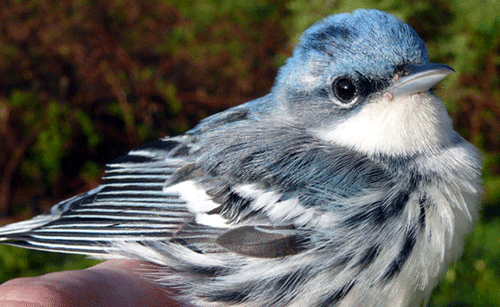March - April 2010

Apple Blossoms

After a long winter and the snow began to melt away, we began to prepare for the spring migration season. One of the challenges present at every banding station is habitat management. This is especially important when one of the goals is to monitor changes in bird populations over time because habitat can strongly influence capture rates.
In order to maintain the banding area at Powdermill taller vegetation is removed periodically. In March high school students participating in a Student Conservation Association (SCA) program spent a weekend helping us with this task.

Blooming marsh marigold dappled in sunlight - spring is here!

Other signs of spring included the emergence of mourning cloak butterflies and the return of Tree Swallows and American Robins.
Mourning Cloak pictured.

Tree Swallow

Robins can be aged as SY and ASY individuals by the presence or absence of molt limits among the feathers on their wings.
After-second-year robin. This bird was aged by the lack of a molt limit among its wing feathers.

This second-year robin was aged by the presence of a molt limit among the greater coverts and another among the alula feathers. Notice that the outer 3 greater coverts are juvenile feathers and these contrast with the replaced greater coverts and carpal covert (both replaced during the 1st prebasic molt).
The arrow on the left is to the outer most replaced greater covert and the right arrow is to the carpal covert.

In spring, blackbirds are aged as either SY or AHY individuals. Because young blackbirds can undergo a complete 1st prebasic molt, a bird lacking molt limits should be aged AHY. However, most SY birds show a molt limit among the underwing coverts.
This SY male cowbird shows a strong molt limit among its underwing coverts (black feathers are replaced while brown feathers are retained juvenile).

This SY female red-winged blackbird also can be aged by the presence of a molt limit. Arrows point to replaced feathers.

SY male Rusty Blackbird (arrow points to molt limit).

The Northern Cardinal is another species that can undergo a complete 1st prebasic molt, and thus, birds are identified as either SY or AHY birds during the spring. In cardinals, SY birds often have a molt limit among the primary coverts and retain some juvenile feathers among the secondaries.
This SY female cardinal underwent a near complete 1st prebasic molt, but the outer 2 primary coverts (arrow) are brown in color and represent juvenile feathers.

A male cardinal with a cracked beak.


Although eye color is frequently used to age towhees in the fall, it is generally not very useful in the spring. However, this SY male was aged using both eye color and the presence of a molt limit.
The wing of the same towhee (photo at bottom to your left) with retained outer greater coverts (3), the 2 larger alula feather (A2, A3) and all primary coverts. Many towhees will replace all of these coverts except for the primary coverts.

An ASY and an SY male Purple Finch. Male Purple Finches, like American Redstarts, demonstrate delayed plumage maturation.

We did not capture any Red-breasted Nuthatches this spring, but this individual was photographed foraging in the walkway leading up to the banding office.

Although many species seemed to arrive late, this Swainson's Thrush was captured on April 17, which was 10 days earlier than one had ever been captured during a spring at Powdermill.

Swainson's Thrush (as well as the other thrush in eastern North America) can often be aged by the presence/absence of a molt limit within the greater coverts. Typically, the inner 2-3 greater coverts are replaced (their coloration matches that of the back feathers) and the the rest are retained (the left arrow points to the molt limit in this bird).
In Swainson's Thrush, SY birds (or HY in the fall) often show buffy spots on the coverts below their alula feathers and the arrow on the right points to this characteristic.

We captured an ASY male Cerulean Warbler on April 27. Although this species breeds in the area, they are seldom captured at Powdermill.
The last CERW captured during spring migration at Powdermill was in 2006.

Another early migrant captured at Powdermill was this ASY male Nashville Warbler.

And an ASY female Northern Parula on April 27th.

We held our beginner bander development workshop during the last week of April.
Jenn Smetzer (one of the participants) is shown here holding a Ruby-throated Hummingbird that has yet to realize it is "free to go". Jenn is a Masters student at UMass working with shrubland birds in New England.
Check back soon as a May update will be posted shortly!
